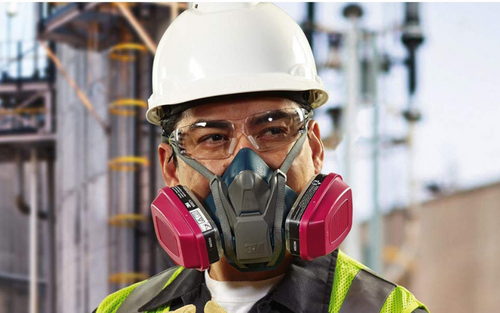Understanding Respirators With Organic Vapor Cartridges
In today’s dynamic industrial environments, several processes involve exposure to hazardous airborne contaminants. Frequently, these include organic vapors found in everyday materials, such as solvents, paints and lacquers, adhesives, fuels, and refrigerants. Prolonged exposure to these vapors can cause a range of health problems, from eye, nose, and throat irritation to more serious illnesses like kidney damage and even cancer (Medical News Today, 2024).
Fortunately, respirators with organic vapor cartridges offer a straightforward, albeit critical, line of defense against these health risks.
What Is an Organic Vapor Cartridge?
An organic vapor cartridge is a replaceable respirator filter that removes organic vapors from being inhaled in the air. Organic vapor cartridges contain activated carbon, which absorbs organic compounds, preventing them from entering the respiratory system.
These cartridges are typically color-coded and labeled to indicate the specific contaminants they can filter, helping workers and safety managers choose the appropriate cartridge for their needs. Versatile solutions are also available, such as the 3M 6001 organic vapor cartridge, which provides NIOSH-approved protection for a range of organic vapors, including acetone, toluene, and gasoline.
The National Institute for Occupational Safety and Health (NIOSH) is the federal agency responsible for testing and approving respirators used in US workplace settings. According to the Centers for Disease Control and Prevention, “When an employer determines that respiratory protection is necessary in a workplace, the Occupational Safety and Health Administration (OSHA) requires the use of NIOSH-approved respirators (CDC, n.d.).
Applications of Organic Vapor Cartridges in Industry
Every day, workers across industries are exposed to organic chemicals and solvents. Below are some common applications for organic vapor cartridges:
- Chemical Manufacturing: Workers involved in the production, handling, or storage of chemicals often require organic vapor cartridges to protect themselves from vapors released during mixing, processing, or spills.
- Painting and Coating: Paints, varnishes, and lacquers emit organic vapors, making organic vapor cartridges essential personal protective equipment (PPE) for workers such as automotive paint technicians, furniture finishers, and construction workers.
- Printing: Inks and other solutions used in various printing processes often contain organic solvents.
It’s important to note that some applications require using a prefilter in addition to the organic vapor cartridge. For instance, spray painting and pesticide applications require prefilters, such as the 3M 5P71 or 3M 5N11. A filter retainer is required for secure attachment.
How Organic Vapor Cartridges Provide Protection
Organic vapor cartridges work through the absorption, where activated carbon within the cartridge traps and holds organic vapors. Activated carbon is typically made by heating coal, wood, or coconut shells in nitrogen or steam at approximate temperatures of 800-900 °C. This process results in materials with significant amounts of micropores that help absorb various organic vapors.
Here’s a closer look at how this process works:
- Absorption mechanism: Activated carbon in the cartridge has a large surface area with numerous micropores. When organic vapors pass through the cartridge, the air is filtered as vapors condense into these carbon pores. This prevents the vapors from reaching the user’s respiratory system.
- Selectivity: Organic vapor cartridges target specific types of organic vapors. Their micropores can be measured and optimized for specific product needs and performance. The effectiveness of the cartridge can also depend on the chemical compatibility between the vapor and the activated carbon. However, activated carbon alone cannot absorb other vapors, such as acid gases, ammonia, and formaldehyde. Additional metals and salts are usually added to the carbon to filter out these types of compounds.
- Capacity: The capacity of an organic vapor cartridge to absorb vapors is finite, influenced by factors including exposure concentration, temperature, humidity, and breathing rate. Over time, the activated carbon becomes saturated and loses its effectiveness. Most cartridges come with guidelines on their lifespan and indicators that signal when replacement is needed.
Remember, organic vapors can enter the cartridge during storage. As such, always be mindful of end-of-service life indicators and follow the manufacturer’s replacement guidelines to maintain optimal protection.
Choosing the Right Organic Vapor Cartridge
Here are some factors to consider when choosing a cartridge to ensure protection from harmful vapors:
- Identify the contaminants: Determine the specific organic vapors present in your work environments and their concentration levels. This may require consulting safety data sheets or conducting air detection using multi-gas monitors.
Select the cartridge type: Use the color-coding system to identify the appropriate cartridge for your needs. For example, cartridges for organic vapors typically have black labels, while pink and black labels are for certain organic vapors and particulates.
- Check for NIOSH approval: Ensure the cartridge is NIOSH-approved for the specific types of vapors and concentration levels in your workplace. NIOSH approval signifies rigorous testing and guarantees a minimum level of protection.
- Respirator compatibility: Ensure the cartridge is compatible with your respirator model. Different brands and models may require specific cartridges.
Contact PK Safety if you’re unsure which organic vapor cartridge is appropriate for your specific applications.
Popular Models: 3M Organic Vapor Cartridges
3M has had a long history of developing high-quality and reliable respiratory kits and protection equipment. Here are some popular models of 3M organic vapor cartridges to consider:
- 3M Organic Vapor Cartridge 6001: Suitable for various applications,the 6001 may be used for vapor concentrations up to 10 times the Permissible Exposure Limit (PEL) with half facepieces or 50 times PEL with full facepieces.
- 3M 60921 Organic Vapor Cartridge/P100 Filter: This product combines a charcoal-filled organic vapor cartridge with a P100 filter. It’s an ideal protective solution for workers in petrochemical, construction, transportation, and chemical manufacturing.
- 3M 6003 Organic Vapor/Acid Gas Cartridge: The 3M 6003 has granulated charcoal that absorbs organic vapors and certain acid gases, including chlorine, hydrogen chloride, and sulfur dioxide. It is commonly used in agriculture, petrochemicals, and pharmaceuticals.
PK Safety offers these organic vapor cartridges and other respiratory protection products from leading manufacturers. Contact our worker safety experts to learn more.
References:
- Medical News Today (May 13, 2024). Health effects of volatile organic compounds. Retrieved from Volatile organic compounds (VOCs): Health effects and risks (medicalnewstoday.com)
Centers for Disease Control and Prevention (n.d.) The Respiratory Protection Information Trusted Source. Retrieved from Use of NIOSH-approved Respirators | NPPTL | NIOSH | CDC
Recent Posts
-
Hand and Eye PPE Machinists Rely On
Machining environments are inherently dangerous, with workers often surrounded by heavy machinery …Sep 18th 2024 -
Understanding Respirators With Organic Vapor Cartridges
In today’s dynamic industrial environments, several processes involve exposure to hazardous airbo …Sep 16th 2024 -
The Importance of Safety Helmets With Chin Straps: Why OSHA Prefers Them Over Hardhats
Introduction to OSHA's Helmet Safety Guidelines Head injuries in the workplace remain a serious …Sep 11th 2024





